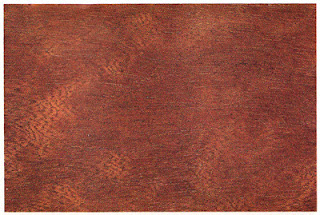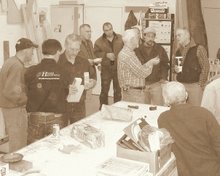What's in your Woodworking Library?
Tim and I are bibliophiles. We love books and we love reading. We each have a stack of books in the bedroom (this is Tim's current stack, left) and our an extensive library fills shelves in three rooms of our five-room house.
Living in a rural state like Montana, books help us stay connected to the wider world, to inspiration and education through reading about what others in our fields are doing all over the world. With that in mind, I'd like to ask any woodworkers or wood-lovers who wish to, to share with the rest of the guild, which books have inspired you, taught you, kept you going in your chosen craft.
Fine Woodworking #121 included an article titled, Woodworking Libraries in which five craftsmen talk about the books they have most valued over their careers. You have to be a member of Taunton's online service to read the pdf file (FW's reference service is well worth the $!)
Here is an excerpt by Alphonse Mattia, a furniture design teacher at the Rhode Island School of Design. He uses a metaphor of escaping to a small island studio with only the bare essentials of life and his craft. As his tiny rowboat takes on water he jettisons his woodworking books a few at a time until just one book remains:
How about it, all you woodworkers out there? Tell us what's in your library and we'll start a list on essential woodworking books in the sidebar. Magazines and journals count too!"I only have my inspirational books left, and the boat is still taking on water. Ways of Seeing and About Looking by John Berger and The Nature and Art of Workmanship by David Pye are sent to the depths. Joseph Campbell's The Power of Myth and The Hero with a Thousand Faces are next. Carol F. Pearson's The Hero Within follows. These books help us discover ourselves and understand our journeys as artists.
Robert G. Henricks' translation of Lao-tzu's Te-Tao Ching would be the last to go. It's a Bible of sorts. My books go down like the Titanic, slipping silently into a powerful swirling vortex ... created by their weighty significance.
Then I remember that these books are only symbols of knowledge. I've read them (or at least looked at the pictures) and assimilated what I could at the time. I haven't really lost them. And I still have my single most important book. It's the one book every artist should have, the record of my development and the map of my journey. Never complete because it describes an ongoing and nonlinear process that branches out and reconnects. Ultimately, that sketch book is the most valuable book of all."
 I'd love it if you shared some of your favorite books and magazines -- either woodworking or inspirational -- by leaving a comment after this post. Or, if you'd rather, just send me an email to helenawoodworkers@gmail.com with a list, long or short, or books on your shelves. Thanks.
I'd love it if you shared some of your favorite books and magazines -- either woodworking or inspirational -- by leaving a comment after this post. Or, if you'd rather, just send me an email to helenawoodworkers@gmail.com with a list, long or short, or books on your shelves. Thanks.--Maureen, CBO











